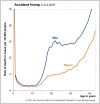(Press-News.org) A team of researchers from the University of the Basque Country (Spain) has developed a method to determine the chemical composition of liquids seized by police and suspected to be explosive. Some of the samples analysed contained substances hazardous to health, such as methanol and boric acid.
Each year police forces seize tonnes of pyrotechnic substances which, in principle, are for indoor firework manufacturing (i.e. flares or those used in artistic or sporting events), but which also may end up in the hands of violent groups and hooligans.
A group of chemists from the University of the Basque Country (UPV/EHU, Spain) has developed a method that offers judges conclusive scientific tests on the nature of these liquids. Until now, many resources have been allocated to detecting high explosives such as TNT, but very few for less powerful ones which can also be dangerous.
"We have found a relatively simple way to detect explosive or flammable compounds in suspicious liquids, by combining four techniques commonly used in laboratories," stated Kepa Castro, UPV/EHU researcher and the study's lead author.
On one hand, the molecular composition of the substances is obtained using two spectroscopy techniques (Raman and infrared) that can be performed with mobile devices in airports, customs or ports offices.
On the other hand, energy-dispersive spectroscopy (EDS) combined with scanning electron microscopy (SEM) images is used to determine which elements are in the sample.
"With the SEM-EDS technique we are able to observe how the sample's elements are distributed and grouped (for example, calcium with sulphur suggests that calcium sulphate is present)" explains Castro, "and by crossing data from four different techniques, we are able to check and confirm the results."
Samples with dangerous compounds
To check the method, the scientists applied it to five seized liquid samples. Four of the samples presented substances used in indoor fireworks. Alcohols, such as isopropyl and methanol, are used to solubilise compounds and the scientists managed to produce coloured flames with them.
The team was surprised to find methanol being used as a main solvent, given that this compound is very toxic for human beings, causing acidosis and blindness, and it is restricted in many countries.
Boric acid was also detected in one of the other sample liquids. This substance has recently been added to the list of Substances of Very High Concern (SVHC) as part of the European Union's REACH Regulation (Registration, Evaluation, Authorisation and Restriction of Chemical substances). These acids can have a negative effect on the human reproduction system.
Strangely, no flammable or explosive substances were found in the fifth sample. "It is probably a flame retardant, which is precisely used in fire prevention," suggested the researcher.
INFORMATION:
References:
Kepa Castro, Silvia Fdez-Ortiz de Vallejuelo, Izaskun Astondoa, Félix M. Goñi, Juan Manuel Madariaga. "Are these liquids explosive? Forensic analysis of confiscated indoor fireworks". Analytical and Bioanalytical Chemistry 400:3065�, 2011. DOI 10.1007/s00216-011-5013-4.
Are those liquids explosive?
2011-08-19
ELSE PRESS RELEASES FROM THIS DATE:
Revealed: How sticky egg captures sperm
2011-08-19
Researchers have uncovered exactly how a human egg captures an incoming sperm to begin the fertilisation process, in a new study published this week in the journal Science.
The research identifies the sugar molecule that makes the outer coat of the egg 'sticky', which is vital for enabling the sperm and egg to bind together. Researchers across the world have been trying to understand what performs this task for over thirty years.
The scientists behind this study believe their work could help address some of the previously unexplained causes of human infertility and ...
CSHL neuroscientists show activity patterns in fly brain are optimized for memory storage
2011-08-19
Large-scale imaging shows mushroom body activity patterns are sparse and randomly distributed Cold Spring Harbor, NY – We know from experience that particular smells are almost inseparable in our minds with memories, some vague and others very specific. The smell of just-baked bread may trigger an involuntary mental journey, even if for a moment, to childhood, or to a particular day during childhood. Or it may, more diffusely, remind someone of grandma. How are these associations forged in the brain and how do we remember them? A research team at Cold Spring Harbor ...
Boys reach sexual maturity younger and younger
2011-08-19
This release is available in German.
Boys are maturing physically earlier than ever before. The age of sexual maturity has been decreasing by about 2.5 months each decade at least since the middle of the 18th century. Joshua Goldstein, director of the Max Planck Institute for Demographic Research in Rostock (MPIDR), has used mortality data to prove this trend, which until now was difficult to decipher. What had already been established for girls now seems to also be true for boys: the time period during which young people are sexually mature but socially not yet considered ...
Study raises doubts about value of heart ultrasound before elective surgery
2011-08-19
TORONTO, Ont., Aug. 18, 2011_A new study has found no evidence that patients who had a heart ultrasound known as an echocardiogram before major surgery had improved survival rates one month or one year after their operation.
Some groups of patients actually had worse survival rates, according to Dr. Duminda Wijeysundera, a scientist at the Li Ka Shing Knowledge Institute of St. Michael's Hospital and the Institute for Clinical Evaluative Sciences.
His study, published in the British Medical Journal, adds to a growing body of evidence that echocardiograms may not be ...
UGA physicist helps uncover new data on adenine, a crucial building block of life
2011-08-19
Athens, Ga. – Early Earth's atmosphere provided little shielding for ultraviolet light from space, so many prebiotic molecules, bombarded by it and light of other wavelengths, had a hard time surviving at all. But some molecules became photostable—able to withstand the assault and thrive as building blocks of life.
Five of the many molecules that survived the bombardment from UV light were the nucleic acid bases adenine, cytosine, guanine, thymine and uracil. Now, in just published research, a University of Georgia physicist and a collaborator in Germany have shown that ...
Study finds sex differences in mental illness
2011-08-19
WASHINGTON – When it comes to mental illness, the sexes are different: Women are more likely to be diagnosed with anxiety or depression, while men tend toward substance abuse or antisocial disorders, according to a new study published by the American Psychological Association.
Published online in APA's Journal of Abnormal Psychology, the study looked at the prevalence by gender of different types of common mental illnesses. The researchers also found that women with anxiety disorders are more likely to internalize emotions, which typically results in withdrawal, loneliness ...
Embryo development obeys the laws of hydrodynamics
2011-08-19
Vincent Fleury, a researcher at the Paris Diderot University, studied the early stage of development when embryonic cells first form a flat sheet of cells before folding into a U-shape, resembling a folded pancake. He demonstrated that the formation of a chicken's head is a consequence of the collision between both sides of the embryo flowing at constant speed towards each other.
This study captured for the first time on film highly accurate observations of how a chicken embryo evolves during its first two days of development, using time-lapse microscopy. Prior attempts ...
A quick way to grade grasses for ethanol yields
2011-08-19
This release is available in Spanish.
U.S. Department of Agriculture (USDA) researchers have developed an inexpensive way to grade the ethanol potential of perennial grasses at the biorefinery's loading dock.
That future has been made possible by a team of Agricultural Research Service (ARS) scientists, including Ken Vogel, Rob Mitchell, and Steve Masterson at Lincoln, Neb.; Hans Jung at St. Paul, Minn.; Bruce Dien at Peoria, Ill.; and Michael Casler at Madison, Wis. ARS is USDA's chief intramural scientific research agency, and this research supports the USDA priority ...
Headaches are common in year following traumatic brain injury, especially among females
2011-08-19
New Rochelle, NY, August 18, 2011—Recurring headaches are common during the year following a traumatic brain injury (TBI), regardless of the severity of the TBI, and they tend to occur more often among females and those with a pre-TBI history of headache, according to an article in Journal of Neurotrauma, a peer-reviewed journal published by Mary Ann Liebert, Inc. The article is available free online at www.liebertpub.com/neu
More than 70% of patients who had suffered a TBI reported having headaches during the first year after their injury. This finding is a result of ...
PET scans confirm effectiveness of estrogen-blocking drugs in breast cancer patients
2011-08-19
SEATTLE – For the first time, researchers at Seattle Cancer Care Alliance have demonstrated the feasibility of using serial positron emission tomography (PET) scans, using a special estrogen-containing isotope, to confirm the relative effectiveness of estrogen-blocking and estrogen-depleting therapy in patients with metastatic breast cancer. The results of the research are published online in Clinical Cancer Research.
The PET scans, taken before, during and after hormonal therapy, confirmed the superior effectiveness of estrogen-receptor-blocking drugs such as tamoxifen ...


